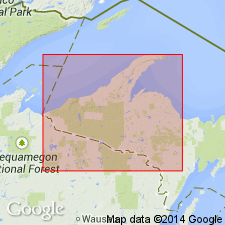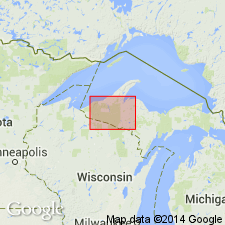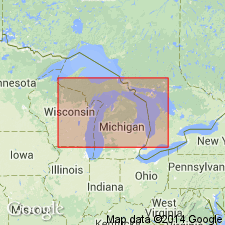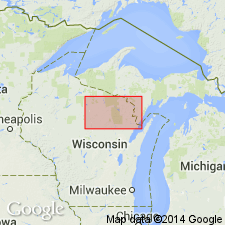
- Usage in publication:
-
- Baraga group*
- Modifications:
-
- Original reference
- Dominant lithology:
-
- Quartzite
- Slate
- Greenstone
- Iron-formation
- AAPG geologic province:
-
- Lake Superior region
Summary:
Pg. 27, 30 (table 1), 35-36. Baraga group. As defined, comprises most of strata referred to as Upper Huronian of previous reports, namely, Goodrich quartzite (basal formation), and Michigamme slate, the lower part of which in Marquette district includes Bijiki iron-formation member, Clarksburg volcanics member, and Greenwood iron-formation [member]. In Iron and Dickinson Counties, six formations are represented: Goodrich quartzite (lowermost unit), Hemlock formation, Fence River formation, and its probable correlative, Amasa formation, Michigamme slate, and Badwater greenstone (new). In the sequence, Baraga is younger than Menominee group and older than Paint River group (new). Age is middle Precambrian (Animikie). Report includes stratigraphic sequence chart.
Named from Baraga Co., Northern Peninsula, northwestern MI, in which the rocks of this group are widely exposed.
Source: US geologic names lexicon (USGS Bull. 1200, p. 212).

- Usage in publication:
-
- Baraga Group*
- Modifications:
-
- Revised
- AAPG geologic province:
-
- Lake Superior region
Summary:
Pg. 2844, 2845 (fig. 2, stratigraphic chart compiled from Leith and others, 1935; James, 1958; Gair and Thaden, 1968). Baraga Group of James (1958) reassigned to newly named Marquette Range Supergroup (replaces †Animikie series of James, 1958, south of Lake Superior, in Michigan and Wisconsin). In Marquette Range, includes (ascending) Goodrich Quartzite and Michigamme Slate (incl. Greenwood Iron-Formation, Clarksburg Volcanics, and Bijiki Iron-Formation Members). In Iron River-Crystal Falls district, includes (ascending) Hemlock Formation, Amasa Formation, Michigamme Slate, and Badwater Greenstone. In Menominee Range, includes (ascending) Michigamme Slate and Badwater Greenstone. Absent in Gogebic Range. Unconformably or disconformably overlies Menominee Group. In Iron River-Crystal Falls district, underlies Paint River Group. Part of group is probably correlative with Animikie Group of Gunflint Range, Ontario, Canada, and Mesabi Range, Minnesota. Age is middle Precambrian.
Source: Publication.

- Usage in publication:
-
- Baraga Group*
- Modifications:
-
- Revised
- AAPG geologic province:
-
- Lake Superior region
Summary:
Baraga Group of Marquette Range Supergroup. Present in Iron River-Crystal Falls district and western Marquette Range, northwestern Michigan. Stratigraphically restricted; Amasa and Hemlock Formations removed and reassigned to Menominee Group. In Iron River-Crystal Falls district, Baraga includes (ascending) Michigamme Formation and Badwater Greenstone. In western Marquette Range, includes (ascending) Goodrich Quartzite, or equivalent unnamed volcanic sedimentary unit, and Michigamme Formation. Is equivalent to Michigamme Formation and Copps Formation of Wakefield-Marenisco area. Separated from overlying Paint River Group and underlying Menominee Group by low-angle unconformity. Age is Early Proterozoic.
Source: Modified from GNU records (USGS DDS-6; Denver GNULEX).

- Usage in publication:
-
- Baraga Group*
- Modifications:
-
- Geochronologic dating
- AAPG geologic province:
-
- Lake Superior region
Summary:
Pg. 3-4, geologic time scale (inside front cover). Baraga Group of Marquette Range Supergroup. Sample from a carbonate-apatite bed in an iron-formation near base of Baraga Group, in bed of the Huron River, Big Eric's bridge, in NW/4 sec. 35, T. 52 N., R. 30 W., Lat. 46 deg. 51 min. 50 sec. N., Long. 88 deg. 05 min. 00 sec. W., [McComb Corner 7.5-min quadrangle], Baraga County, Michigan. This uraniferous cherty phosphorite is presumed to be derived from organic material (Mancuso and others, 1975, Econ. Geol., v. 70, p. 583-586). Iron-formation unconformably overlies an Archean granitic basement complex; grades upward into black slate of Michigamme Formation of Baraga Group. Essentially concordant U-Pb ages appear reasonable for time of sedimentation or early diagenesis of the Baraga. Whole-rock (split 1) U-Pb ages: 1,920 +/-10 Ma, 1,924 +/-14 Ma, and 1,928 +/-24 Ma. Whole-rock (split 2) U-Pb ages: 1,934 +/-24 Ma, 1,942 +/-14 Ma, and 1,950 +/-10 Ma. Ages calculated using decay constants of Steiger and Jager, 1977 (Earth Planet. Sci. Letters, v. 36, p. 359-362). [Early Proterozoic (Precambrian X)]
Source: Publication.

- Usage in publication:
-
- Baraga Group*
- Modifications:
-
- Revised
- AAPG geologic province:
-
- Lake Superior region
Summary:
In Florence area, Wisconsin, stratigraphic position of Badwater Greenstone of Baraga Group is reinterpreted. Is part of upper plate of thrust fault (Badwater thrust) placing unit tectonically, rather than stratigraphically, above Michigamme Formation of Baraga Group. Thus, Badwater is actually older than Michigamme, younger than sedimentary rocks of Menominee Group, and is now correlated with Hemlock Formation of Baraga Group. Age is Early Proterozoic.
Source: Modified from GNU records (USGS DDS-6; Denver GNULEX).

- Usage in publication:
-
- Baraga Group
- Modifications:
-
- Overview
- AAPG geologic province:
-
- Michigan basin
Summary:
Baraga Group of Marquette Range Supergroup. In the Iron River-Crystal Falls district of Michigan, includes (ascending) Goodrich Quartzite (150 m), Hemlock Formation (1,830 m), Amasa Formation (550 m), Michigamme Formation (1,830 m), and Badwater Greenstone (4,570 m). [Cannon (1986) had removed Amasa, Fence River, and Hemlock Formations from the Baraga and placed them in the underlying Menominee Group.]
Source: GNU records (USGS DDS-6; Reston GNULEX).
For more information, please contact Nancy Stamm, Geologic Names Committee Secretary.
Asterisk (*) indicates published by U.S. Geological Survey authors.
"No current usage" (†) implies that a name has been abandoned or has fallen into disuse. Former usage and, if known, replacement name given in parentheses ( ).
Slash (/) indicates name conflicts with nomenclatural guidelines (CSN, 1933; ACSN, 1961, 1970; NACSN, 1983, 2005, 2021). May be explained within brackets ([ ]).

